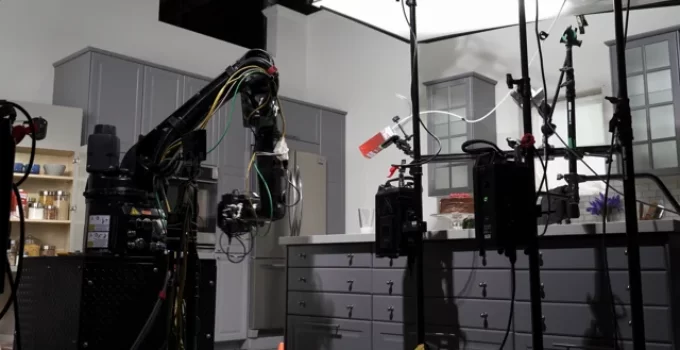In the world of filmmaking, technology plays a crucial role in capturing captivating visuals that leave audiences mesmerized. Over the years, advancements in cinematography have pushed the boundaries of creativity and storytelling. One such innovation that has revolutionized the industry is the cinema robot. With its ability to provide precise motion control and capture high-speed footage using cutting-edge cameras, the cinema robot has become an indispensable tool for filmmakers. In this article, we will explore the concept of cinema robots, their impact on visual engineering, and the role of high-speed cameras in creating stunning cinematic experiences.
- Introduction: The Evolution of Visual Engineering
Over the years, filmmakers have constantly strived to push the boundaries of visual storytelling. The evolution of visual engineering has played a vital role in achieving this goal. From traditional camera setups to advanced digital technologies, the industry has witnessed significant transformations. Among these innovations, cinema robots have emerged as a game-changer.
- What is a Cinema Robot?
A cinema robot is a sophisticated robotic system designed specifically for the film industry. It combines precise motion control with high-speed camera capabilities to capture dynamic shots that were previously unimaginable. These robots are equipped with state-of-the-art technology and advanced algorithms, allowing filmmakers to achieve smooth camera movements with unparalleled precision.
- Understanding Motion Control
Motion control is a fundamental aspect of cinematography. It involves controlling the movement of the camera to create visually stunning shots. Cinema robots excel in providing precise motion control, allowing filmmakers to execute complex camera movements flawlessly. Whether it’s a sweeping crane shot or a seamless tracking shot, cinema robots can achieve it all with exceptional accuracy.
- The Power of High-Speed Cameras
High-speed cameras are a vital component of the cinema robot system. These cameras are capable of capturing footage at incredibly high frame rates, enabling filmmakers to create slow-motion sequences with unparalleled detail and clarity. With the ability to record thousands of frames per second, high-speed cameras add a new dimension to visual storytelling, capturing moments that are imperceptible to the naked eye.
- Visual Engineering: Creating Cinematic Masterpieces
Visual engineering is an art form that involves combining technology, creativity, and storytelling to create cinematic masterpieces. Cinema robots, with their precise motion control and high-speed camera capabilities, have become an integral part of the visual engineering process. They enable filmmakers to capture breathtaking shots that evoke emotions and immerse audiences in the story.
- The Role of Cinema Robots in Filmmaking
Cinema robots have transformed the way films are made. They offer filmmakers unprecedented control over phantom camera movements, allowing them to execute complex shots with ease. From sweeping aerial shots to intricate dolly movements, cinema robots open up a world of possibilities for visual storytelling. Filmmakers can now bring their creative visions to life with precision and finesse.
- Applications of Cinema Robots in Different Genres
Cinema robots find applications in various genres of filmmaking. In action films, they enable filmmakers to capture high-octane sequences with dynamic camera movements. In sci-fi movies, they can create otherworldly shots that transport audiences to different dimensions. Even in intimate dramas, cinema robots can add a layer of visual poetry, enhancing the emotional impact of the story.
- Advantages and Limitations of Cinema Robots
Like any technology, cinema robots come with both advantages and limitations. One of the key advantages is their ability to provide precise and repeatable camera movements, eliminating human error. They also offer filmmakers the flexibility to experiment with different shot compositions. However, cinema robots can be expensive to acquire and require skilled operators to unleash their full potential.
- Choosing the Right Cinema Robot for Your Project
Selecting the right cinema robot for a project is crucial. Factors such as payload capacity, speed, and versatility need to be considered. Filmmakers should assess their specific requirements and consult with experts to determine the best fit for their needs. Additionally, training and technical support should be available to ensure a smooth workflow and optimal results.
- The Future of Visual Engineering and Cinema Robots
As technology continues to advance, the future of visual engineering and cinema robots looks promising. We can expect even more sophisticated robotic systems with enhanced capabilities to enter the market. These innovations will empower filmmakers to push the boundaries of creativity further and captivate audiences with immersive visual experiences.
Conclusion
Cinema robots have revolutionized visual engineering in filmmaking. Through precise motion control and the power of high-speed cameras, these robotic systems have elevated the art of storytelling. From capturing awe-inspiring shots to enhancing emotional moments, cinema robots enable filmmakers to create cinematic masterpieces that leave a lasting impression on audiences.
Q1. Are cinema robots suitable for independent filmmakers with limited budgets?
A1. While cinema robots can be expensive, there are options available that cater to various budget ranges. Independent filmmakers can explore more affordable alternatives that still provide impressive capabilities.
Q2. Can cinema robots be used in live events or documentaries?
A2. Yes, cinema robots find applications beyond traditional filmmaking. They can be utilized in live events, documentaries, and other productions where precise camera movements are required.
Q3. Do cinema robots require extensive technical knowledge to operate?
A3. Operating a cinema robot requires some technical knowledge and training. However, manufacturers often provide resources and support to ensure filmmakers can make the most of their systems.
Q4. Can cinema robots be integrated with virtual reality (VR) technology?
A4. Yes, cinema robots can be integrated with VR technology to enhance immersive experiences. This combination allows filmmakers to create virtual worlds with seamless camera movements.
Q5. Where can I get access to cinema robots and related equipment?
A5. To explore cinema robots and related equipment, you can visit reputable manufacturers and distributors or consult with industry professionals who specialize in visual engineering.



